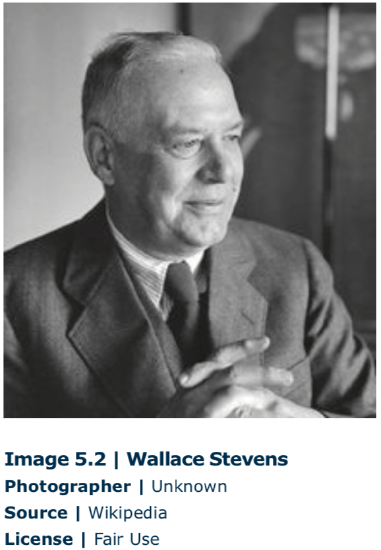5.3: Wallace Stevens (1879 - 1955)
- Page ID
- 26034

Wallace Stevens’s reputation as an American poet has undergone something of a transformation over the sixty years since his death in the middle of the twentieth century. Celebrated during his lifetime for his imagery and for his attempts to unite the real world with the imagination, Stevens was also the target of frequent criticism for both the ordinary subjects of his early poetry and for the abstractness of his later work. Those who celebrate Stevens’s work often point to this dichotomy, between the world of commerce and the world of the mind, as evidence of Stevens’s particularly American upbringing. Unlike many of his generation, Stevens did not shy from commerce or industry in pursuit of his art; instead, he embraced both halves of himself by working during the day as a lawyer and insurance company executive and by writing poetry in the evenings and on vacation. While many modernist poets considered it a badge of honor to support themselves solely through their writings, Stevens saw no conflict in pursuing both the world of real things and the flights of the imagination. These were the stuff of poetry, not of conflict. From his first collection, Harmonium, published in 1923, to The Collected Poems of Wallace Stevens, published in 1954, the year before his death, Stevens resolutely mixed the ordinary and the imaginary in poems that are technically sophisticated while accessible to a wider audience.
The two selections from Stevens in this section highlight these two aspects of his poetry. In the first, “The Emperor of Ice-Cream” (1923), the poet uses just sixteen lines to connect the reader to an ordinary funeral, one in which there are no grand flourishes or flagrant displays, but only mourners in everyday clothes, bouquets of flowers wrapped in newspaper, and a widow who covers her face with a dresser cloth. Juxtaposed against a poet like Whitman, who celebrates the body, here in this poem we never even see the deceased in repose; nonetheless we know that he is an ordinary man. By 1923 Stevens warns us that the only emperor, the only one to deserve or receive a grand funeral, is the emperor of ice cream.
The second selection from Stevens is the much-quoted “Of Modern Poetry” (1942), which has become an iconic twentieth-century poem. Here Stevens makes his own argument for poetry that picks up on Marianne Moore’s call for more precise language that is found in her own poem, “Poetry” (1921), included earlier in this chapter. Stevens, like Moore, argues that a poem “has to be living” (7), and therefore poetry must embrace the simple language of ordinary things in order for the imagination to create images. Yet, Stevens cautions poets and readers that modern poetry must not seek merely to represent an image; it must also connect to the imagination in order for it to succeed. These two selections are but a small portion of Stevens’s rich body of work, but in reflecting both the early and the later parts of his career as a poet, they show a consistency of purpose, and a dedication to the natural language of readers, that few equaled in the twentieth century.
5.4.1 “The Emperor of Ice Cream”
Call the roller of big cigars,
The muscular one, and bid him whip
In kitchen cups concupiscent curds.
Let the wenches dawdle in such dress
As they are used to wear, and let the boys
Bring flowers in last month’s newspapers.
Let be be finale of seem.
The only emperor is the emperor of ice-cream.
Take from the dresser of deal,
Lacking the three glass knobs, that sheet
On which she embroidered fantails once
And spread it so as to cover her face.
If her horny feet protrude, they come
To show how cold she is, and dumb.
Let the lamp affix its beam.
The only emperor is the emperor of ice-cream.
5.4.2 “Of Modern Poetry”
Please click the link below to access this selection:
5.4.3 Reading and Review Questions
- How does Stevens’s use of everyday language and situations shape the subjects of his poetry?
- Compare Stevens’s “Of Modern Poetry” to Marianne Moore’s “Poetry.” How do these authors understand the roles and responsibilities of poets?


